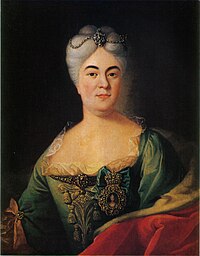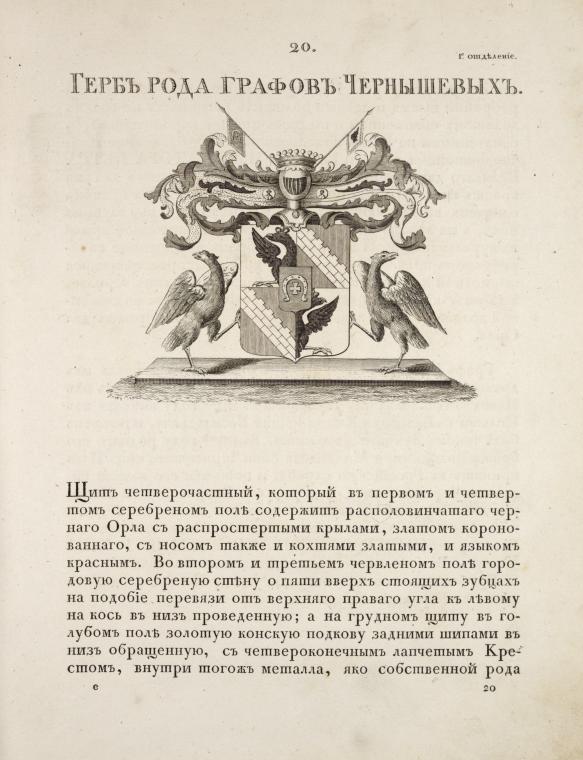 Above: Eudoxia Ivanovna Chernysheva, wife of Gen. Grigory P. Chernyshev.
Countess Avdotya (Evdokia) I. Chernyshev, born Rzhevskaya, wife of General Grigory Petrovich Chernyshev, was nicknamed "Avdotya virago" by Tsar Peter I (February 12, 1693 - June 17, 1747).
One of the mistresses of Peter the Great, according to Vilboa her 'disorderly conduct had a detrimental effect on the health of Peter.' She became the mother of the brothers Chernyshev -- prominent figures of the reign of Catherine II.
Daughter of Ivan Rzhevsky and Daria Gavrilovna (nee Sokovnin), she received from Peter the mock title of "Prince Mother Superior."
In 1710, Avdotya married Count Gregory Petrovich Chernyshev (1672-1745), the future Earl, General-in-Chief, Senator, and Governor-General of Moscow. In dowry Peter I gave them 4 thousand serfs, which was very enriching to the groom, who had his own estate.
In 1715, five years after their wedding, Avdotya participated in a mock wedding ceremony between her mother and "Prince-Pope" N. M. Zotov, a former teacher of Peter the Great.
Avdotya was in Polish costume, and her husband in "accessorized" dress.
Using her great influence on Peter I, Avdotya had an impact on the rise of her husband. Upon her sons Peter bestowed "from his heart" money and villages. Moreover, members of the royal family itself resorted to her for her aid interceding with the king.
There were the following rumors about her:
As a girl of fifteen she was thrown on the bed of the king, and at sixteen, Peter married her to an officer who was looking for a promotion, Chernyshev, and maintained his contact with her. In Eudoxia there was born to the king four daughters and three sons, at least, he was called the father of these children. However, taking into account the too-frivolous nature of Eudoxia, Peter's true fatherhood was more than doubtful. This greatly reduced her chances as favorite. If we believe the scandalous chronicles, it resulted in the famous orders: "Go and whip Avdotya." This order was given to her husband by her lover, who felt ill and blamed Eudoxia for his illness. [Letter from Anna Petrovna to the estate councilor Prince Theodore Golitsyn]
Of the disease it was written as follows: "Peter died of complications of cystic disease of the same kind that caused the death of Francis I, King of France. Some argue that the culprit of the disease was Mrs. Chernyshev."
Francis I, in fact, died of syphilis. However, Avdotya after Peter's death gave birth to children, and lived another twenty years, which raises doubts about such a terrible diagnosis.
In 1717, Avdotya's name appeared in connection with that of a lady-in-waiting beheaded for infanticide, Mary Hamilton, with whom Peter was sleeping. Mary took a new lover, the royal orderly Ivan Orlov, who was also cheating on her with Avdotya.
Wanting to humiliate her rival for Peter's affection, Mary told her new lover the orderly Orlov that Chernysheva was spreading a rumor that Empress Catherine ate wax to keep her face clear of acne. She then told the court ladies that Chernysheva herself said this to Orlov.
Returning from a trip, Orlov was horrified to learn of all the gossip about him, and he ran to throw himself at the feet of the Empress. Catherine, to whom these rumors had not yet arrived, was surprised, and angrily called Hamilton, who at first refused to admit starting the rumor, then, when they "beat her," confessed. This investigation, which brought to light the facts of Hamilton's abortion and her baby killing, eventually led to her death.
Chernyshev results: not affected.
Above: Eudoxia Ivanovna Chernysheva, wife of Gen. Grigory P. Chernyshev.
Countess Avdotya (Evdokia) I. Chernyshev, born Rzhevskaya, wife of General Grigory Petrovich Chernyshev, was nicknamed "Avdotya virago" by Tsar Peter I (February 12, 1693 - June 17, 1747).
One of the mistresses of Peter the Great, according to Vilboa her 'disorderly conduct had a detrimental effect on the health of Peter.' She became the mother of the brothers Chernyshev -- prominent figures of the reign of Catherine II.
Daughter of Ivan Rzhevsky and Daria Gavrilovna (nee Sokovnin), she received from Peter the mock title of "Prince Mother Superior."
In 1710, Avdotya married Count Gregory Petrovich Chernyshev (1672-1745), the future Earl, General-in-Chief, Senator, and Governor-General of Moscow. In dowry Peter I gave them 4 thousand serfs, which was very enriching to the groom, who had his own estate.
In 1715, five years after their wedding, Avdotya participated in a mock wedding ceremony between her mother and "Prince-Pope" N. M. Zotov, a former teacher of Peter the Great.
Avdotya was in Polish costume, and her husband in "accessorized" dress.
Using her great influence on Peter I, Avdotya had an impact on the rise of her husband. Upon her sons Peter bestowed "from his heart" money and villages. Moreover, members of the royal family itself resorted to her for her aid interceding with the king.
There were the following rumors about her:
As a girl of fifteen she was thrown on the bed of the king, and at sixteen, Peter married her to an officer who was looking for a promotion, Chernyshev, and maintained his contact with her. In Eudoxia there was born to the king four daughters and three sons, at least, he was called the father of these children. However, taking into account the too-frivolous nature of Eudoxia, Peter's true fatherhood was more than doubtful. This greatly reduced her chances as favorite. If we believe the scandalous chronicles, it resulted in the famous orders: "Go and whip Avdotya." This order was given to her husband by her lover, who felt ill and blamed Eudoxia for his illness. [Letter from Anna Petrovna to the estate councilor Prince Theodore Golitsyn]
Of the disease it was written as follows: "Peter died of complications of cystic disease of the same kind that caused the death of Francis I, King of France. Some argue that the culprit of the disease was Mrs. Chernyshev."
Francis I, in fact, died of syphilis. However, Avdotya after Peter's death gave birth to children, and lived another twenty years, which raises doubts about such a terrible diagnosis.
In 1717, Avdotya's name appeared in connection with that of a lady-in-waiting beheaded for infanticide, Mary Hamilton, with whom Peter was sleeping. Mary took a new lover, the royal orderly Ivan Orlov, who was also cheating on her with Avdotya.
Wanting to humiliate her rival for Peter's affection, Mary told her new lover the orderly Orlov that Chernysheva was spreading a rumor that Empress Catherine ate wax to keep her face clear of acne. She then told the court ladies that Chernysheva herself said this to Orlov.
Returning from a trip, Orlov was horrified to learn of all the gossip about him, and he ran to throw himself at the feet of the Empress. Catherine, to whom these rumors had not yet arrived, was surprised, and angrily called Hamilton, who at first refused to admit starting the rumor, then, when they "beat her," confessed. This investigation, which brought to light the facts of Hamilton's abortion and her baby killing, eventually led to her death.
Chernyshev results: not affected.
With the accession to the throne of Anna Ivanovna, Avdotya Chernysheva was appointed one of the eight ladies of state (May 3, 1730), a great position for one with the ability to tell the Empress jokes and news.
Anna highly favored the lady Countess Avdotya Ivanovna Chernysheva, who could well recount the city news and anecdotes, but in spite of this the Empress would never allow her to sit in her presence. Once Chernysheva, talking to the Empress, felt unwell and could barely stand up. Anna Ivanovna, noticing this, said to her companion, "you may lean on the table, the maid overshadow you, and so I will not see your posture."
With the new Empress, Elizabeth, Avdotya managed to maintain her influence -- her husband got the rank of Count (1742) and the St. Andrew ribbon.
Widowed (1745), Chernysheva retired from the court and two years later she died. She was buried in the Alexander Nevsky Lavra.
Portrait of Czar Peter the Great (1672 -1725) by Paul Delaroche.
The Czar often fathered children on the wives of his officers,
"Among
the Czar's mistresses was a certain Eudoxia, the wife of Captain
Tchernichov [Chernyshev]. Peter called her boi-baba, 'the virago.' She gave birth to seven children [the
Chernyshev family], of whom it was impossible to tell which were by her husband
and which by her lover. From his
relations with her Peter contracted a venereal disease, which he transmitted to
Catherine. To punish the faithless one
for having contaminated him, he had her whipped by her husband."
Source: Troyat, Henri. Peter the Great (London: Hamish Hamilton,
1987) p. 265
"Husbands
sensibly learned to turn a blind eye when it became apparent that their wives
had taken the Czar's fancy. One of Peter's mistresses was married to an army
captain named Tchernichov. She gave
birth to seven children, and no one was quite sure, not even their mother,
which were the husbands and which were the Czar's. When she gave Peter
syphilis, however, the Czar was furious and instructed the husband to give her
a sound whipping."
Shaw, Karl.
Royal Babylon: The Alarming History of European Royalty (New York: Broadway
Books, 1999) p. 116
Several biographies of Gregory Chernyshev's children mention that Czar Peter was their "godfather." He certainly became the patron of Gregory's sons, and helped to promote their military and diplomatic careers.
DESCENDANTS OF
GRIGORY PETROVICH CHERNYSHEV
Eudoxia Rhzevskaia had the following children:
1. Natalya
Grigorievna Chernysheva (1711 - 1760) who married Michael Beloselsky (1702
- 1755) and had three sons and three daughters (see below);
2. Peter
Grigorievich Chernyshev (1712 - 1773) who married Catherine Ushakov (1715 -
1779) and had four daughters (see below);
3. Gregory
Grigorievich Chernyshev (1717 - 1750) who died unmarried at age 33.
4. Maria
Grigorievna Chernysheva (1718 - ?)
5. Zahar
Grigorievich Chernyshev (1722 - 1784) b. Jan 11, 1722 or 1723, d. August 29
/ September 9, 1784, married Ann Veydel (1744 - 1830).
6. Anna
Grigorievna Chernysheva (1723 - 1770)
7. Ivan
Grigorievich Chernyshev (1726 - 1797) died Feb 26 / March 9, 1797, buried
at Alexander Nevsky Monastery, St. Petersburg. Married twice and had issue.
m. 1 Elizabeth Efimoskaya,
m. 2 Anna Isleneva (d. 1794), and had
a son and two daughters (see below)
8. A fourth daughter
(unnamed)
 The Chernyshevs of Russia descend from Teutonic Knights of Poland. The inverted horseshoe and Maltese cross incorporated into their Russian Coat of Arms seem to be based on the Polish Coat of Arms for the family Czernyszew. The arms for the families Czernicki and Czerniecki are very similar.
The Chernyshevs of Russia descend from Teutonic Knights of Poland. The inverted horseshoe and Maltese cross incorporated into their Russian Coat of Arms seem to be based on the Polish Coat of Arms for the family Czernyszew. The arms for the families Czernicki and Czerniecki are very similar. 






